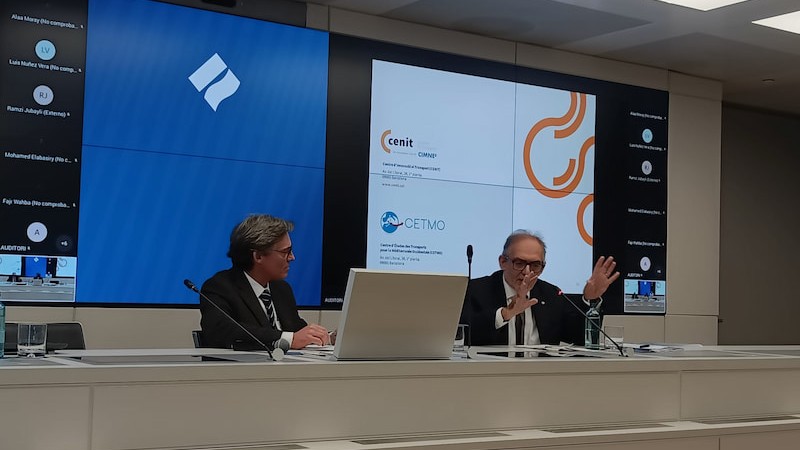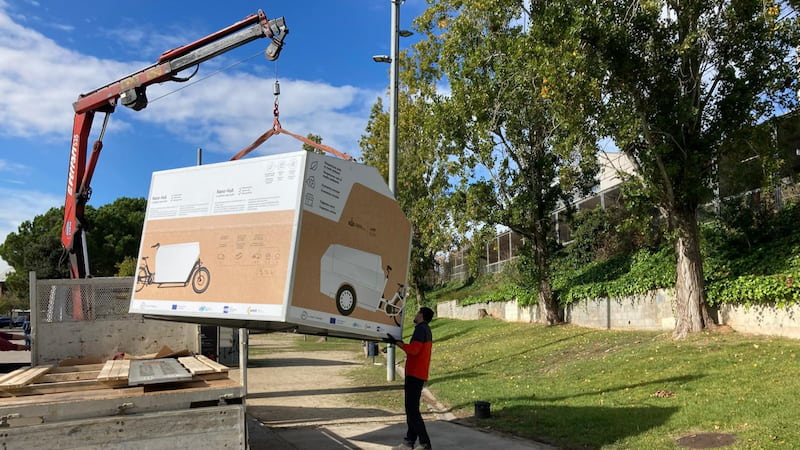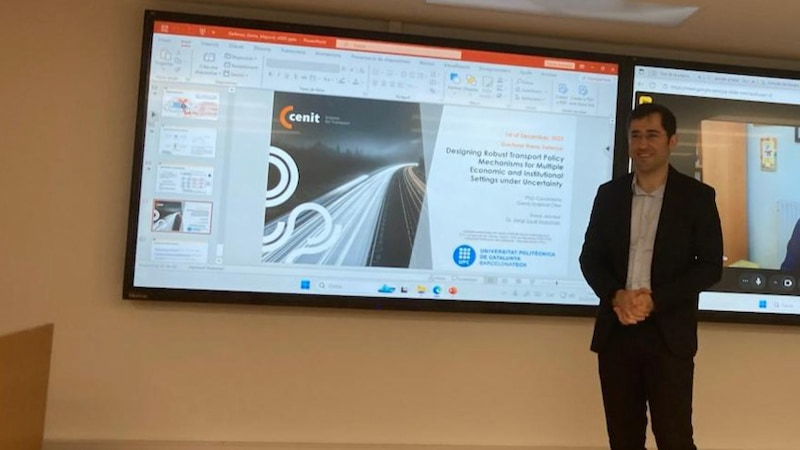By Clara Soler i Bañuelos
In the coming years, public transport authorities will face unprecedented financing challenges amidst radical transformations in urban mobility. CIMNE's Innovation Unit in Transport, CENIT, operates at the critical intersection of research, training, and technology transfer, directly addressing both societal and industry requirements emerging from transport's evolving landscape of challenges and opportunities.
Transport researchers have identified several converging trends reshaping urban mobility: demographic shifts including urban population growth and aging, evolving commuter patterns, widespread digitalization, disruptive mobility services, stringent environmental regulations, and the rise of sustainable finance frameworks. Urban population expansion will likely necessitate substantial increases in public transport funding, as research indicates financing requirements for urban transit systems increase disproportionately relative to city size. Environmental compliance presents another significant pressure point, with the European Commission establishing ambitious CO2 reduction targets in its Transport White Paper: a 20% reduction from 2008 levels by 2030 and a more ambitious 60% reduction from 1990 levels by 2050.
The European Commission estimates that there will be a significant increase in funding gap requirements in urban public transport for the period 2010-2040. According to their estimates, the total yearly operating expenditure for this period will increase by 84% on average. Even though the operating expenditure will grow faster in EU-12 cities (at 2.8% per annum) than in EU-15 cities (at 1.5% per annum), EU-15 cities will still require a higher amount of funding per inhabitant. The expected capital expenditure requirement is estimated to increase by 105% on average during this period. In this case, EU-15 cities will also contribute to a higher proportion of this funding gap in absolute terms.
This article aims to assess how the most relevant trends (directly and indirectly linked to mobility) will affect the financing of urban public transport and, from there, to establish policy recommendations for the financing of public transport. To this end, the main trends affecting urban public transport will be identified, differentiating both those that are typical of urban mobility and those that are exogenous but have an impact on mobility.
Regarding the endogenous tendencies to urban mobility, in recent years a series of changes and technologies have emerged that are beginning to shape future possibilities for the coming years. Those are:
Autonomous and connected vehicles
This is a technology that is being developed in strength in recent years. In the United States, for example, it is estimated that between 20% and 95% of kilometres travelled on American roads will be done with automatic vehicles in 2030. This will mainly make it possible to make better use of road capacity, improve traffic and reduce accidents. However, studies show that as long as current vehicles and autonomous vehicles coexist, there may be an increase in accidents. A reduction in accidents will only be effective when there are more autonomous vehicles on the roads.
Another effect of this technology is related to the value of time. If travel time is a cost and directly proportional to the value of time, with autonomous vehicles people will be able to perform other activities while driving, which will reduce the value of time. The effects that this can have in the long term are relevant. The main effect is an increase in the population living outside cities but working there, which translates into greater mobility in terms of vehicle kilometres.
Zero emission vehicles
Sales of electric vehicles have increased in recent years, but still remain at a modest rate. For example, in 2015 electric passenger vehicles represented only 1.2% of the new vehicle fleet in the EU. This positively and directly affects GHV emission reductions per private vehicle and bus. However, it should be noted that at present the acquisition costs of this technology are much more expensive than conventional vehicles. Also, because of various issues including increased use, significant investment will be needed to extend and expand the electric vehicle supply network. In many countries there is an active policy to promote this type of mobility, as is the case in Europe.

Shared mobility (car-sharing and bike-sharing)
There is a general inclination to classify them as new services, but shared mobility is a concept that is several decades old. The possibilities afforded by new communication and information technologies (ICTs), together with the growth of the collaborative economy, have given a great boost to this form of mobility in recent years.
However, this type of mobility has to be seen as a complement to mass transport systems. Although their current volumes are not large compared to overall mobility, they are a good complement to overcome the weaknesses of current public transport services, so that the integration of these two forms of mobility can constitute a competitive offer to the private vehicle.
The different forms of shared mobility make it possible to improve three of the main weaknesses of public transport from the point of view of the quality perceived by the user: availability, reliability and comfort.
Some of the studies carried out to analyse shared mobility on the transport system indicate that there is a trend towards less vehicle ownership and a reduction in spending on transport among users of shared mobility, as well as encouraging the use of public transport.

Mobility as a service (MaaS)
Defined as a system in which a company offers a wide range of mobility services to customers from the existing supply, MaaS is a natural evolution of the current service of different public transport operators to offer an integrated fare and/or an integrated payment system, as is the case in most major European cities. A logical next step is to integrate mobility services provided by private operators into the existing system and to complement the supply of public transport by offering last-mile services, thus providing a complete and seamless mobility service.
New communication and information technologies (ICTs)
In general terms, we can differentiate between effects that could be classified in the short and medium term with those of long term.
At the first stage, new ICT services allow us to process a greater volume of data, of higher quality and in real time, which will enable more effective decisions and adaptability to the changing needs of mobility. While planning will continue to be based on a static, long-term time horizon, especially for transport systems linked to major investments, the new data available will allow better short-term adaptability of supply to variable demand. This improvement to service operations will have a direct impact on the quality of service as perceived by the user.
Another of the implications of new ICTs for urban public transport in the short and long term is the emergence of possible additional services to users. With the processing of data from customers it will be possible to articulate other services in addition to those traditionally associated with public transport and that will represent not only an additional source of income to the urban public transport but also improvements in the quality perceived by the customer.
Pricing of the urban public transport (UTP)
With electronic payment systems that provide traveller data, it will be possible to define second-order price discrimination tariff systems, reducing consumer surplus and increasing income for UTP, thereby improving the system's financing. For example, mobile payment systems can enable fare structures based on the number of trips each user takes per month and the distance travelled within the public transport system, from entry to exit stations.
However, one of the most important and profound aspects of mobility linked to ICTs will have a long-term effect. Different fields of study linked to sociology and epistemology warn «of the importance of the implications of new technologies on the structures and mental processes of individuals» (M. Castells, 1997). These changes significantly influence how individuals conceive of and approach mobility, allowing them to accept and conceive of travel as a combination of different modes of transport or to make shared use of the vehicle, to mention two examples. Especially in urban areas, we are moving from a modal mobility where a service provider or a mode has to compete with the others to a multimodal and shared mobility. This means sharing both the use of the vehicle and the integration of public and private transport. The concept of mobility as a service must be placed in this context.
This change in approach to mobility is likely to have two effects: reduced private vehicle ownership and planning for an integrated supply of transport modes, including public and private, especially in densely populated urban environments.
Finally, and in another order, we cannot ignore the role that mobility is playing in the generation of new business segments in the technology sector, either in the creation of new start-ups or within already established companies.

On-demand service
New technologies are making it possible to develop on-demand public transport services (buses and cabs). This type of service will be especially relevant in low-density areas with low demand, where having a transport system with pre-established schedules means excessive costs. This will leader to a greater attractiveness of public transport.
Multimodality
Travel from one point to another is becoming increasingly multi-modal. This is due to the convergence of several factors: the application of technology to the operation of public transport systems, which facilitates more effective modal changes; and the determination, on the basis of mobility policies, to encourage multimodality in order to make more effective use, according to each stage of a journey, of each mode of transport. This last aspect is promoted by intermodal stations and the definition of complementary public transport networks.
Mobility policies
These are increasingly active in reducing the negative impacts derived from the mass use of private vehicles. In practice, this takes the form of measures: on the one hand, by limiting or penalising the use of private vehicles, as is the case with urban tolls, low emission zones (LEZs), restrictions on street parking, etc. And, on the other hand, by promoting the use of the most sustainable modes of transport: cycling, walking and public transport, especially by improving the offer. In the end, the objective is to reduce the urban space dedicated to private vehicles and give it back to citizens. For mobility purposes, this means thinking of all modes of transport in terms of the network and seeking synergies between them.
ABOUT THE AUTHOR
 Clara Soler Bañuelos is a Civil Engineer. She obtained her bachelor’s degree from the Polytechnic University of Catalonia and obtained her master’s double degree with the Illinois Institute of Technology specializing in Transportation Engineering. Prior to starting her PhD, she worked as an Associate Project Manager in a construction project for Ferrovial in Atlanta, Georgia.
Clara Soler Bañuelos is a Civil Engineer. She obtained her bachelor’s degree from the Polytechnic University of Catalonia and obtained her master’s double degree with the Illinois Institute of Technology specializing in Transportation Engineering. Prior to starting her PhD, she worked as an Associate Project Manager in a construction project for Ferrovial in Atlanta, Georgia.
She is currently developing her PhD with the Departament de la Vicepresidència i de Polítiques Digitals i Territori. Research includes topics related to transportation demand, where she is working with VISUM models and origin-destination matrices for private cars (by using data from smart phones) and for public transport (from the validation tickets). She has also experience with the simulation demand model of Chicago TRANSIMS.









